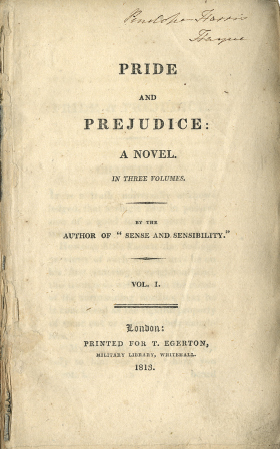Pride and Prejudice
Jane Austen
(1813)
Jane Austen’s romantic comedy of manners pokes fun at some absurdities of English social life at the end of the eighteenth century, but the human foibles that she represents recur in every age.
Such is the universal popularity of Pride and Prejudice that even those who have never read it will recognise its opening line: ‘It is a truth universally acknowledged that a single man in possession of a good fortune must be in want of a wife.’ It’s a teaser for the novel to come, setting out its themes of class, wealth, gender and matrimony with playful irony. An eighteenth-century man had many ways to advance in life besides marriage – through business or military service, for example – while a woman’s only hope was a good marriage into money.
Jane Austen (1775–1817) was a parish rector’s daughter and lived with her father for the first twenty-five years of her life. She first drafted Pride and Prejudice, under the title First Impressions, when she was just twenty-one. Her father submitted it to a publisher, but it was rejected, and she put it aside. When she returned to it, it was as a mature woman of thirty-five years, the published author of Sense and Sensibility. Reworked and retitled, Pride and Prejudice was well received and, like Sense and Sensibility before it, quickly sold out its first edition of 750 copies. It has sold an estimated twenty million copies since.
The novel chronicles the courtship of middle-class Elizabeth Bennet and upper-class Fitzwilliam Darcy, who form prejudiced and erroneous first impressions of each other – Elizabeth jumps to conclusions because she prides herself on making swift, accurate assessments of new acquaintances. Darcy’s pride in his class leads him automatically to reject Elizabeth and hers. The stumbling blocks to their love caused by these character flaws of prejudice and pride are compounded by others that Austen throws in their way. Love eventually overcomes almost all the false barriers of society, resulting in a plethora of marriages for Elizabeth and her sisters, only one of whom weds for money.
Austen uses several literary devices to tell her story. Events are often reported in the indirect speech of her characters. This creates a degree of distance from which to absorb the narrative, while also placing the reader at the heart of the action, as if eavesdropping on conversations.
Austen also relies heavily on letters as a way of moving the story on. It has been suggested that First Impressions may have been an entirely epistolary novel – that is, one that conveys its narrative through exchanges of correspondence. Letters allow characters and authors time for reflection, unlike the immediacy of conversation.
Finally, many scenes in Pride and Prejudice are set at large social gatherings of one sort or another, a perfect way to illustrate the absurdities of England’s class-ridden society. Austen held a progressive view on class divisions and particularly on the place of women in society. Many of her characters are trapped in the roles that society has dictated for them. But Elizabeth and Darcy grow as they learn about themselves and each other, overcoming their pride and prejudice. In the end, love conquers all, and that’s a story the world never tires of reading.

The frontispiece of the 1833 edition (above) and title page of the 1813 edition (opposite). The frontispiece shows Elizabeth telling her father that Darcy was responsible for uniting Lydia and Wickham: ‘She then told him what Mr. Darcy had voluntarily done for Lydia. He heard her with astonishment.’


